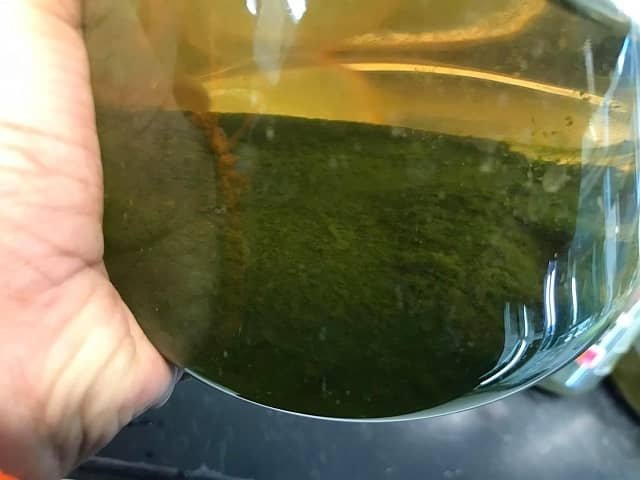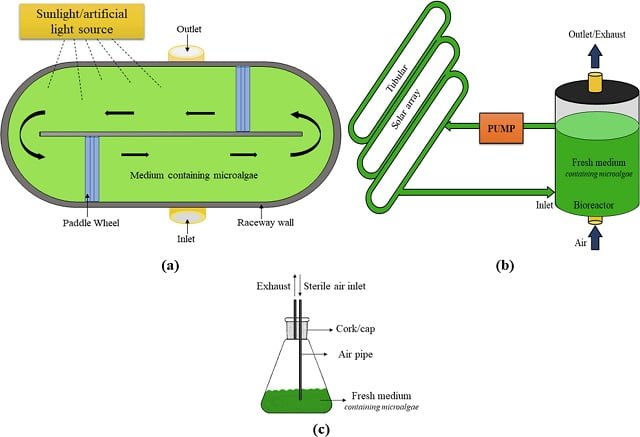
In the ever-expanding quest for sustainable energy sources, microalgae have emerged as biofuel powerhouses, particularly in biodiesel production.
Microalgae, microscopic organisms with the remarkable ability to accumulate significant lipid reserves, have become valuable resources in the renewable energy landscape. However, the high production costs associated with microalgae biodiesel have prompted exploration focused on cultivation conditions that can maximize lipid productivity.
In this regard, a team of scientists from the Institute of Plant Physiology RAS published a scientific review where they systematized information on nitrogen and phosphorus restriction to increase lipid production in microalgae from different taxonomic and ecological groups.
The research included Cyanobacteria, Rhodophyta, Dinophyta, Haptophyta, Cryptophyta, Heterokontophyta/Ochrophyta (Bacillariophyceae, Eustigmatophyceae, Xanthophyceae), and Chlorophyta.
The Nitrogen and Phosphorus Puzzle: Balancing Growth and Lipid Content
- 1 The Nitrogen and Phosphorus Puzzle: Balancing Growth and Lipid Content
- 2 Nitrogen and Phosphorus in Microalgae Cultivation
- 3 Challenge of Nutritional Stress Studies: A Call for Standardization
- 4 Nutrient Media Designations
- 5 Mapping the Future: Unveiling Research Directions
- 6 Entradas relacionadas:
A key strategy to enhance lipid productivity in microalgae cultivation involves manipulating nitrogen and phosphorus levels in the culture medium. Striking a delicate balance between achieving maximum growth and optimizing lipid content and productivity is the central goal of numerous experimental efforts.
The rationale behind this approach lies in the understanding that altering nutrient availability can redirect microalgae metabolic pathways towards lipid accumulation.
Nitrogen and Phosphorus in Microalgae Cultivation
The range of nitrogen and phosphorus concentrations in nutrient media for microalgae cultivation is broad, ranging from 0.007 g L-1 to 0.417 g L-1 and from 0.0003 g L-1 to 0.227 g L-1, respectively. The N:P ratio, a critical factor in nutrient balance, varies between 0.12:1 and 823.33:1. Achieving the right balance at these nutrient levels is crucial to influencing lipid production.
However, the researchers caution that “optimal nitrogen and phosphorus ratios differ for freshwater and marine microalgae, planktonic and benthic.”
Stay Always Informed
Join our communities to instantly receive the most important news, reports, and analysis from the aquaculture industry.
Challenge of Nutritional Stress Studies: A Call for Standardization
When investigating nutritional stress in microalgae, the lack of a standardized approach to determine experimental nitrogen and phosphorus concentrations poses a significant challenge. This variability hinders the correct interpretation of data and can lead to misleading conclusions.
To address this, the researchers conducted a systematic analysis of 301 experiments using the principal component analysis method, covering various taxonomic and ecological groups of microalgae.
Nutrient Media Designations
The culmination of this work resulted in a proposed scheme for designating nutrient media supply for nitrogen and phosphorus. Categories include -N replete (˃0.4 g L−1), -N moderate (0.4–0.2), moderate N limitation (0.19–0.1), strong N limitation (˂0.1), no nitrogen (0), replete -P (˃0.2), -P moderate (0.2–0.02), moderate P limitation (0.019–0.01), strong P limitation (˂0.01), and no phosphorus (0).
This classification system provides a standardized framework for researchers and professionals, facilitating clearer communication and understanding in the pursuit of optimal microalgae lipid productivity.
Mapping the Future: Unveiling Research Directions
Beyond consolidating existing knowledge, this comprehensive analysis serves as a compass pointing towards future research directions. By identifying patterns in diverse groups of microalgae, taxonomies, and experimental conditions, the study paves the way for specific research that can unlock new insights to enhance lipid productivity and, consequently, the viability of microalgae as a sustainable source for biodiesel production.
The researchers also emphasize that microalgae with high potential for biodiesel production due to their high lipid content include Ankistrodesmus falcatus, Ankistrodesmus fusiformis, Chlorella sorokiniana, Chlorella vulgaris, Cylindrotheca fusiformis, Diacronema lutheri, Ettlia oleoabundans, Microchloropsis salina, Microcystis aeruginosa, Nannochloropsis granulata, Nannochloropsis oceanica, Nannochloropsis oculate, Phaeodactylum tricornutum, Prymnesium parvum, Rebecca salina, Tetradesmus deserticola, Tetradesmus obliquus, Tetraselmis suecica, Vischeria magna, and Vischeria vischeri.
In the ever-changing landscape of renewable energy, optimizing microalgae cultivation represents a crucial step towards more ecological and sustainable biodiesel production, offering a glimpse into a future where microscopic organisms play a fundamental role in powering our world.
Contact
Yevhen Maltsev
К.А. Timiryazev Institute of Plant Physiology RAS – IPP RAS
Moscow, 127276, Russia
Email: ye.maltsev@gmail.com
Reference (open access)
Maltsev, Y., Kulikovskiy, M. & Maltseva, S. Nitrogen and phosphorus stress as a tool to induce lipid production in microalgae. Microb Cell Fact 22, 239 (2023). https://doi.org/10.1186/s12934-023-02244-6
Editor at the digital magazine AquaHoy. He holds a degree in Aquaculture Biology from the National University of Santa (UNS) and a Master’s degree in Science and Innovation Management from the Polytechnic University of Valencia, with postgraduate diplomas in Business Innovation and Innovation Management. He possesses extensive experience in the aquaculture and fisheries sector, having led the Fisheries Innovation Unit of the National Program for Innovation in Fisheries and Aquaculture (PNIPA). He has served as a senior consultant in technology watch, an innovation project formulator and advisor, and a lecturer at UNS. He is a member of the Peruvian College of Biologists and was recognized by the World Aquaculture Society (WAS) in 2016 for his contribution to aquaculture.




